How Medtronic designed the PulseSelect pulsed field ablation system for AFib
The world’s largest medical device manufacturer achieved that milestone about 15 years after one of its engineers, Mark Stewart, coined the term “pulsed field ablation” in a research paper about using electroporation for cardiac ablation.
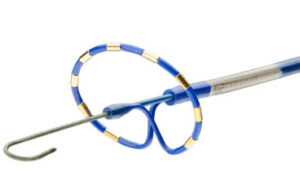
The Medtronic PulseSelect pulsed field ablation (PFA) system is designed to treat paroxysmal and persistent atrial fibrillation (AFIb). [Image courtesy of Medtronic]
“Mark continued to optimize and test waveforms,” Tim Laske, VP of research and business development for Medtronic Cardiac Ablation Solutions, said in an interview with Medical Design & Outsourcing. “He had an internal grant from Medtronic under a program called Quest where engineers are given a certain amount of seed money, and Mark went into the lab and designed some experiments, had a lot of waveforms that didn’t work, and then suddenly came across the one that did. He brought the histological results to us and they fell into the too-good-to-be-true category.”
“We thought, ‘OK, if it is true, we really need to understand this,’” Laske continued. “And at that point, we launched a series of tests on selectivity: does it just impact the myocytes, or could you injure the esophagus, phrenic nerve, etc.? We showed that these particular waveforms had very little amount of hemolysis created, that they created predictable fields with this particular catheter, they were not proarrhythmic — on and on, there’s so many different things you need to consider. And so we settled in on that waveform.”

Medtronic Cardiac Ablation Solutions VP of Research and Business Development Tim Laske [Photo courtesy of Medtronic]
How PulseSelect compares to Medtronic’s Affera PFA catheters
Medtronic is working toward FDA approval for more PFA systems developed by Affera (which Medtronic bought in 2022), but PulseSelect is a very different catheter than the Affera Sphere-9 and Sphere-360.
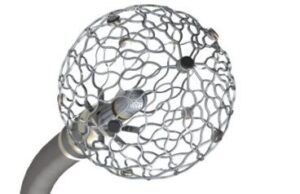
Medtronic’s Affera Sphere-9 mapping and ablation catheter is designed to provide both radiofrequency ablation and PFA to treat AFib. [Photo courtesy of Medtronic]
All of the PFA catheters in Medtronic’s portfolio are designed for both ablation and cardiac mapping, and they all rely on nitinol as a key material. Nitinol (a nickel-titanium alloy with superelastic and shape memory properties) allows the catheter tips to compress for minimally invasive delivery to the heart before expanding to a pre-set shape.
“PulseSelect has nitinol superstructure, which allows it to compress down, and that’s delivered through a 10-Fr catheter and then it’s deployed in a very predictable shape,” Laske said.
That loop shape allows for single-shot ablation, which is the delivery of energy across multiple parts of the pulmonary vein for a procedure that can be simpler and faster. That tissue-selective energy kills cardiac myocytes to block irregular heart signals that cause AFib, but spares phrenic nerves and nerves in the esophagus.
The Affera Sphere-9 is a focal catheter and the Sphere-360 is a single-shot catheter. The Affera catheters use nitinol as the conductive material for their single, global electrodes, while the PulseSelect’s nine electrodes are gold.
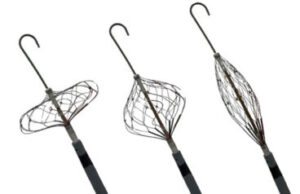
Medtronic’s Affera Sphere-360 pulsed field ablation catheter is adjustable, allowing it to take different shapes inside a patient. [Illustration courtesy of Medtronic]
“In previous versions of that catheter, we had platinum iridium, but found that the thermal conductive properties of gold are much better, so you get better heat distribution,” Laske said. “… Our pulse field waveforms are generally nonthermal. There’s always a small temperature increase whenever you’re delivering current in the tissue, but it’s not to the point where it causes thermal ablation.”
Gold offers appropriate biostability and good sensitivity for electrograms, while having the ability to serve as a high-voltage electrode — critical requirements for PFA electrodes that deliver energy for ablation while also performing the sensing function.
Medtronic tested other form factors — such as focal and linear catheters — before choosing the 25mm loop shape for PulseSelect.
“We liked a number of things about that catheter,” Laske said. “One of the most important is predictable inter-electrode spacing. We’re delivering thousands of volts between two electrodes, and you want to know where they are relative to one another in order to be able to carefully prescribe the dose. The PulseSelect catheter gives us good control over electrode spacing and the field that it generates. The Affera catheters deliver biphasic energy just like PulseSelect, but they’re a unipolar energy modality.”
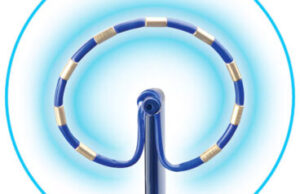
The Medtronic PulseSelect PFA catheter has nine evenly spaced gold electrodes around the 25mm loop. [Image courtesy of Medtronic]
Controlling a fixed distance between electrodes as designed ensures the energy field will create durable lesions through the entire thickness of the target tissue, while avoiding potentially harmful side effects.
“The waveform and the electrode design have to work in concert to what the voltages are, the characteristics in your pulse train, all are tuned to the particular electrode array and the tissue you’re trying to ablate,” Laske said. “Our Pulse Select system was tuned around the particular electrode array. [If electrodes are] too close to one another, then the field density can become quite intense, which can result in excessive hemolysis and you may be ablating tissues that were not targeted, because the voltages that you’re creating could be beyond the threshold that you’re seeking to optimize.”
Designing PulseSelect for tissue contact
Another difference of PulseSelect versus the Affera catheters is that the PulseSelect catheter has a 20-degree forward cant that indicates when the device is in contact with heart tissue.
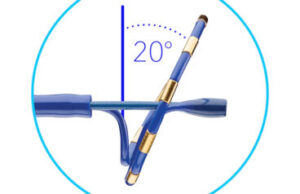
The Medtronic PulseSelect PFA catheter is designed with a 20-degree forward tilt for better tissue contact. [Image courtesy of Medtronic]
“Then as you make contact, it also biases toward all of the electrodes touching the tissue, not just the ones that are in contact,” Laske said. “… What we found is if you come in flat to the surface and the surface is uneven, you tend to have less reliable tissue contact across all nine electrodes than if you have that small cant. The cant on the catheter is a visual indicator for intracardiac echo, fluoro and map/nav systems and also serves to give higher confidence in uniform electrical contact.”
None of Medtronic’s PFA catheters measure force. Laske said testing of the PulseSelect system did not show better or worse ablation from differing force applied by the catheter against heart tissue.
“It’s field-based, so contact gives you deeper lesions. If you have an uneven surface, it will still give you a lesion across that, but not as deep in areas that aren’t in contact,” he said. “For force sensing, we tested that as well. And we did not see an impact of force on the lesions that are created. Again, it’s field-based, so applying more force might compress the tissue slightly with the force, but … it’s going to create a lesion that’s based upon that field and not upon how much force was was applied.”
Medtronic is manufacturing its PulseSelect catheter in-house (along with the Affera catheters), though Laske declined to say whether it is outsourcing the energy generators. But with the internally designed PulseSelect platform already in its sixth-generation of hardware, Medtronic continues to refine the equipment.
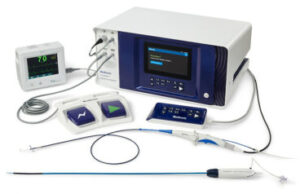
The Medtronic PulseSelect PFA system is on its sixth generation of hardware. [Image courtesy of Medtronic]
“We have engineers in-house that are working on tuning the boards, ensuring that they are safe, produce consistent waveforms, and then focus on DRM principles to ensure that we can produce them safely and at the volumes that are needed by our customers,” he said. “The generators are an integral part of the system, of course. You have to be very sophisticated and and be able to deliver these complex waveforms and do it in a safe, predictable way. There are some basic parameters to the waveform, but if you start getting into the details, there are dozens of different characteristics of the electrical pulse that you can tune — these are very complex instruments.”
Article Source: Medical Design









